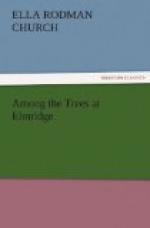“’Great use is made of these canoes by the savages and by the French Canadians in their long journeys into the interior of the country; they are very light, and are easily transported on the shoulders from one lake or river to another, which is called the portage. A canoe calculated for four persons, with their baggage, weighs from forty to fifty pounds; some of them are made to carry fifteen passengers.’
“And now let me show you a picture of the Kentucky pioneer in a birch-bark canoe.”
“Why, Miss Harson, the Indians are trying to kill him!” exclaimed Malcolm.
“Yes,” she replied; “when you read the history of the United States, you will find that not only Daniel Boone, but the most of the early settlers of these Western lands, had trouble with the Indians. Nor is this strange. These pioneers were often rough men, and were looked upon by the natives as invaders of their country and treated as enemies. But to come back to the uses of the bark of the birch:
“’In the settlements of the Hudson Bay Company tents are made of the bark of this tree, which for that purpose is cut into pieces twelve feet long and four feet wide. These are sewed together by threads made of the white-spruce roots; and so rapidly is a tent put up that a circular one twenty feet in diameter and ten feet high does not occupy more than half an hour in pitching. Every traveler and hunter in Canada enjoys these “rind-tents,” as they are called, which are used only during the hot summer months, when they are found particularly comfortable.’”
[Illustration: IN THE BIRCH-BARK CANOE]
“Well, that’s the funniest thing yet!” exclaimed Malcolm. “‘Rind-tents’! I wish I could see one. Did they have any in Maine where you were, Miss Harson?”
“No,” was the reply, “I did not even hear of such a thing there, and to see it you would probably have to go far to the north. The English birch, which is found also in many parts of Europe, is put to a great many uses; the leaves produce a yellow dye, and the wood, when mixed with copperas, will color red, black and brown. An old birch tree that is supposed to be giving an account of itself says,




